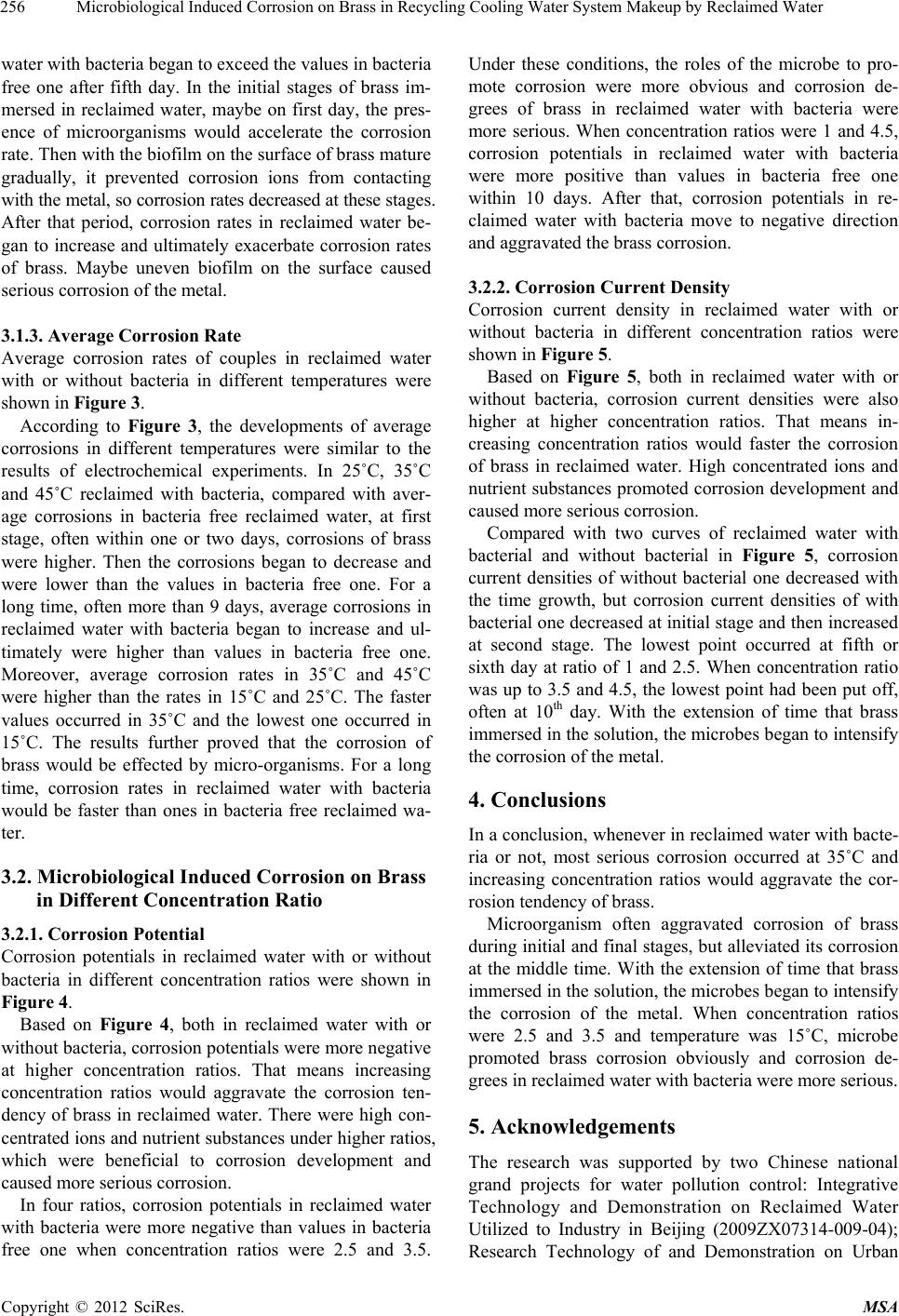
Microbiological Induced Corrosion on Brass in Recycling Cooling Water System Makeup by Reclaimed Water
256
water with bacteria began to exceed the values in bacteria
free one after fifth day. In the initial stages of brass im-
mersed in reclaimed water, maybe on first day, the pres-
ence of microorganisms would accelerate the corrosion
rate. Then with the biofilm on the surface of brass mature
gradually, it prevented corrosion ions from contacting
with the metal, so corrosion rates decreased at these stages.
After that period, corrosion rates in reclaimed water be-
gan to increase and ultimately exacerbate corrosion rates
of brass. Maybe uneven biofilm on the surface caused
serious corrosion of the metal.
3.1.3. Average Corrosion Rate
Average corrosion rates of couples in reclaimed water
with or without bacteria in different temperatures were
shown in Figure 3.
According to Figure 3, the developments of average
corrosions in different temperatures were similar to the
results of electrochemical experiments. In 25˚C, 35˚C
and 45˚C reclaimed with bacteria, compared with aver-
age corrosions in bacteria free reclaimed water, at first
stage, often within one or two days, corrosions of brass
were higher. Then the corrosions began to decrease and
were lower than the values in bacteria free one. For a
long time, often more than 9 days, average corrosions in
reclaimed water with bacteria began to increase and ul-
timately were higher than values in bacteria free one.
Moreover, average corrosion rates in 35˚C and 45˚C
were higher than the rates in 15˚C and 25˚C. The faster
values occurred in 35˚C and the lowest one occurred in
15˚C. The results further proved that the corrosion of
brass would be effected by micro-organisms. For a long
time, corrosion rates in reclaimed water with bacteria
would be faster than ones in bacteria free reclaimed wa-
ter.
3.2. Microbiological Induced Corrosion on Brass
in Different Concentration Ratio
3.2.1. Corrosion Po te ntial
Corrosion potentials in reclaimed water with or without
bacteria in different concentration ratios were shown in
Figure 4.
Based on Figure 4, both in reclaimed water with or
without bacteria, corrosion potentials were more negative
at higher concentration ratios. That means increasing
concentration ratios would aggravate the corrosion ten-
dency of brass in reclaimed water. There were high con-
centrated ions and nutrient substances under higher ratios,
which were beneficial to corrosion development and
caused more serious corrosion.
In four ratios, corrosion potentials in reclaimed water
with bacteria were more negative than values in bacteria
free one when concentration ratios were 2.5 and 3.5.
Under these conditions, the roles of the microbe to pro-
mote corrosion were more obvious and corrosion de-
grees of brass in reclaimed water with bacteria were
more serious. When concentration ratios were 1 and 4.5,
corrosion potentials in reclaimed water with bacteria
were more positive than values in bacteria free one
within 10 days. After that, corrosion potentials in re-
claimed water with bacteria move to negative direction
and aggravated the brass corrosion.
3.2.2. Corrosion Curr ent Densit y
Corrosion current density in reclaimed water with or
without bacteria in different concentration ratios were
shown in Figure 5.
Based on Figure 5, both in reclaimed water with or
without bacteria, corrosion current densities were also
higher at higher concentration ratios. That means in-
creasing concentration ratios would faster the corrosion
of brass in reclaimed water. High concentrated ions and
nutrient substances promoted corrosion development and
caused more serious corrosion.
Compared with two curves of reclaimed water with
bacterial and without bacterial in Figure 5, corrosion
current densities of without bacterial one decreased with
the time growth, but corrosion current densities of with
bacterial one decreased at initial stage and then increased
at second stage. The lowest point occurred at fifth or
sixth day at ratio of 1 and 2.5. When concentration ratio
was up to 3.5 and 4.5, the lowest point had been put off,
often at 10th day. With the extension of time that brass
immersed in the solution, the microbes began to intensify
the corrosion of the metal.
4. Conclusions
In a conclusion, whenever in reclaimed water with bacte-
ria or not, most serious corrosion occurred at 35˚C and
increasing concentration ratios would aggravate the cor-
rosion tendency of brass.
Microorganism often aggravated corrosion of brass
during initial and final stages, but alleviated its corrosion
at the middle time. With the extension of time that brass
immersed in the solution, the microbes began to intensify
the corrosion of the metal. When concentration ratios
were 2.5 and 3.5 and temperature was 15˚C, microbe
promoted brass corrosion obviously and corrosion de-
grees in reclaimed water with bacteria were more serious.
5. Acknowledgements
The research was supported by two Chinese national
grand projects for water pollution control: Integrative
Technology and Demonstration on Reclaimed Water
Utilized to Industry in Beijing (2009ZX07314-009-04);
Research Technology of anDemonstration on Urban d
Copyright © 2012 SciRes. MSA